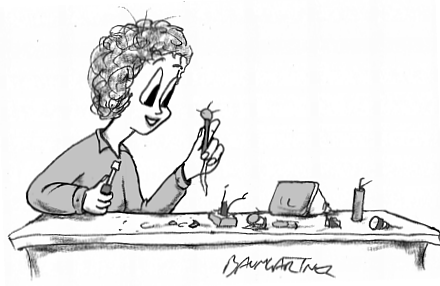
Creativity Is Breaking Things and Playing with The Parts
By Jeffrey Baumgartner
In many ways, creativity is simply a matter of visualising something, breaking it into pieces, playing with those pieces and building them into something new. A creative automotive engineer assigned to improve the fuel efficiency of a motor can visualise the motor, take it apart in her mind, imagine modifications and predict with some accuracy how her modifications will work. Then she proceeds to build a prototype to test and tweak her ideas.
A good cook can eat a delicious curry and then, in her head, break the curry apart into its various ingredients. Perhaps she thinks it is a good curry but there is too much coriander which she is not so fond of. She can imagine how the dish would taste with less coriander and maybe a dash more cumin. She plays with the ingredients in her mind. It could be nice with fish instead of chicken. She can do the same thing with a recipe she finds in a magazine. She can construct it in her mind, modify it and come up with something more suited to her needs. Creative cooks, I find, seldom follow recipes, but are frequently inspired by them.
An artist can look at a figure sitting in front of a window; break that image up into lines and shadow; and draw those lines and shadows. A creative artist can play with the lines and shadows, capturing feelings, emotion and even energy. She can make the image more abstract, surreal or super real.
Of course, the engineer, cook and artist can do this deconstruction in their minds because they have done it in actuality many times. The engineer has taken apart engines, tinkered with the pieces and put the engines back together again. The cook has prepared many different dishes and experimented with ingredients. The artist has drawn many models as well as examined how other artists deconstruct reality in order to reconstruct it in two dimensions on paper.
Business Deconstruction in the Mind
Business creativity and innovation should also involve deconstruction and playing with the pieces. To improve upon a product, you need someone who can break apart the product in her mind, play with the pieces, add new pieces and visualise how it should work. Sadly, many product improvement creativity sessions are limited to managers shouting out words in a brainstorm. Only afterwards are the words, collected and combined by the managers, given to the designer so that she can dismantle the product in her mind and play with ways to achieve the suggestions implied by those words. It would be far more effective to let the designer and others deconstruct the product and play with it from the beginning.
If you are concerned about customer-centric innovation, and by all accounts it is a good thing, then deconstruct the customer experience of using your product. Break it into pieces of action and play with those actions in your mind. How would the customers use a different interface? How might they talk to your product? How might they misuse it?
To devise a new business model, you should be able to break up the current business model, examine the pieces, play with them, replace them and see what happens in your mind. A behavioural psychologist would be useful in such an exercise. She might not know a lot about business models, but business models rely on people behaving in certain ways and she is likely to be able to visualise behaviour in ways that a marketing manager could probably not do.
Actual Deconstruction
If deconstruction of a problem in your mind, or the collective mind of your team, is not viable, consider really deconstructing things. As I have written (and made a short video about) in the past, Lego building bricks, wooden building blocks, crafts materials and similar items can be used to build models of products and problems. You can then play with the various pieces, replace them, move them, add new pieces and see what results.
Dance Deconstruction
In an experiment with a dance trainer friend a couple of years ago, we developed an approach we called dynamic problem solving, in which teams used dance inspired movement to present problems. Participants, some of whom only watched, were then able to identify issues and make suggestions for improvement. These suggestions could then be incorporated into the movement and tested. Effectively, dynamic problem solving creates models of situations, enables people to deconstruct elements of the situations, play with the elements of those situations and try out their ideas.
Words Are Wonderful, but...
Words are wonderful. I have on and off in my life made a living with them. But, unless the end product of your creativity is a product of words, you need to be able to deconstruct things − in your mind, in reality or with models − in order to get truly creative with solutions.




